W.G. Sebald’s long poem Nach der Natur (1988) contributed significantly to the swift recognition of his literary talent among fellow writers and poets, yet it received scant attention by the larger public and literary scholars alike.1 To the English-speaking world it was not even available until 2002, a year after its author’s death, when it appeared in Michael Hamburger’s excellent translation under the title After Nature. Like a triptych, it is divided into three untitled parts, each with a distinct thematic concern involving a specific historical period and a writer or artist: the first focuses on the Renaissance painter Matthias Grünewald, the second on the eighteenth-century naturalist, travel writer, and Arctic explorer Georg Wilhelm Steller, and the last on elements from Sebald’s own biography.2 As opposed to Sebald’s later practice, apart from the landscape photographs that are reproduced on the end sheets of the first edition of Nach der Natur, there are no visuals in the volume, although paintings play a prominent role, especially in the first and final sections of the poem. In what follows, I shall support my reading of Sebald’s poem with reproductions of Grünewald’s paintings. I do so, however, in an attempt to provide a glossary, and I do not want to confuse this with Sebald’s own, later practice of including visuals in his texts.
What fascinates me in this early poem by Sebald is its poetological dimension, the manner in which it provides a sustained reflection on the material aspects of the work of art and on the nature of art in its relationship to history. Moreover, what makes these meditations particularly interesting is their un-timeliness, their departure from what were then especially among literary scholars dominant critical clichés and pious practices, such as the presumed death of the author or the reduction of works of art to their historical contexts. For when he composed Nach der Natur in the late 1980’s, Sebald was a literary scholar and a professor of German Literature at the University of East Anglia in the United Kingdom, specializing in Realism and the literature of the nineteenth- and twentieth-centuries. In that sense one could ascribe a certain autobiographical dimension to this prose poem and read it as a reflection on crossing the threshold of the world of the academic and scholar into the world of artistic production. However, I shall only touch on this autobiographical dimension to the extent that I shall explore how Sebald makes use of another artist, Grünewald, in order to explore the way in which artists give their own face to their work and the way in which they borrow the faces of other artists as an acknowledgement of admiration and influence. Thus I shall focus on the poem’s first part and show how Sebald reflects on Grünewald: the oeuvre, the artist, and the historical persona, but also art historical scholarship about Grünewald.
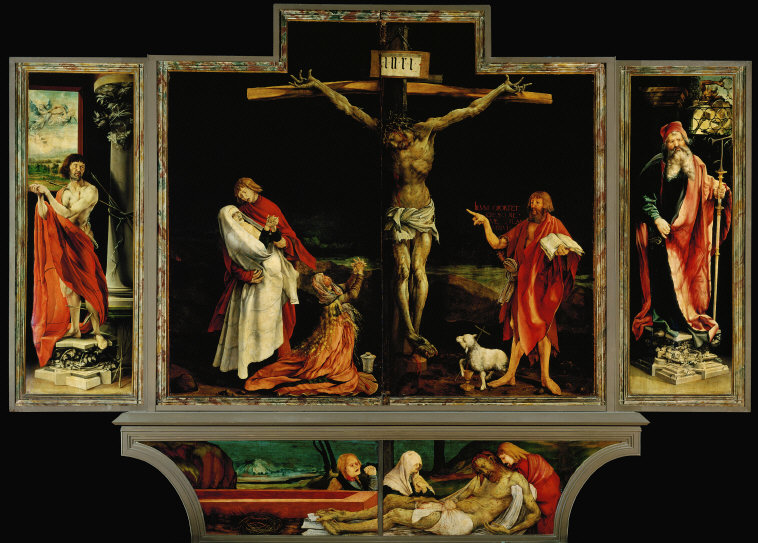
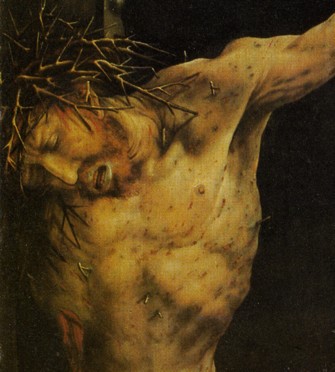

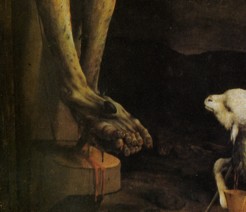
Before approaching Sebald’s meditations on Matthias Grünewald (c.1470-1528), a few remarks about the reception of Grünewald’s work are in order. For the first three centuries after his death, this Renaissance artist did not attract much attention. But around 1900 the French writer Joris-Karl Huysmans made a passionate plea for the relevance and modernity of Grünewald. In his description of the altar at Isenheim, Huysmans called attention to Grünewald’s shocking insistence on the physical details of Christ’s suffering, alerting its beholder to the disgusting marks of torture and the signs of dying and decomposing flesh (figs. 1a and 1b). Such a Christ, Huysmans observed, is no longer the well-groomed, handsome man who has been venerated by the rich and powerful throughout the ages. Grünewald’s Christ is rather the “God of the Poor. The one who chose the company of those in misery and of those who had been rejected, of all those for whose ugliness and need the world could only feel contempt.”3 And it was exactly this approach to pain and suffering highlighted by Huysmans that subsequently became a point of reference for many artists who invoked Grünewald’s work, especially when they cited the triptych from the Isenheim altarpiece or The Mockery of Christ (fig. 2) from the Alte Pinakothek in Munich. Otto Dix and Max Ernst in particular made specific reference to the altarpiece from Isenheim in their works depicting the suffering and destruction wrought by World War I and II (figs. 3a and 3b). Empathy with the suffering as well as the willingness to pay attention to all aspects of pain, decay, and death will also become an important concern for Sebald’s poem, albeit, as we shall see, not through any direct focus on the depiction of the crucified but only in view of the other figures from Grünewald’s work: the bystanders, witnesses, and patron saints.
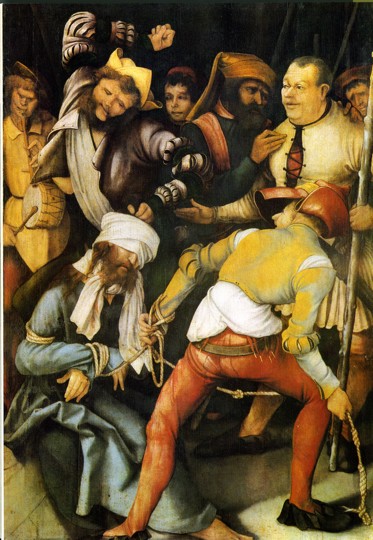
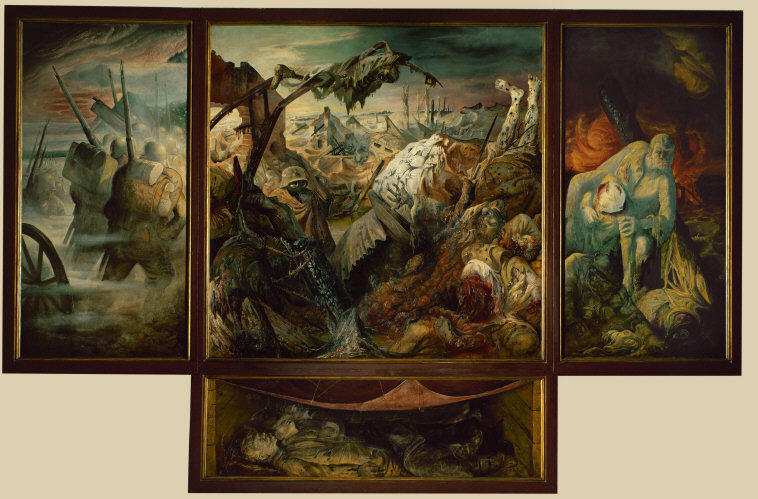
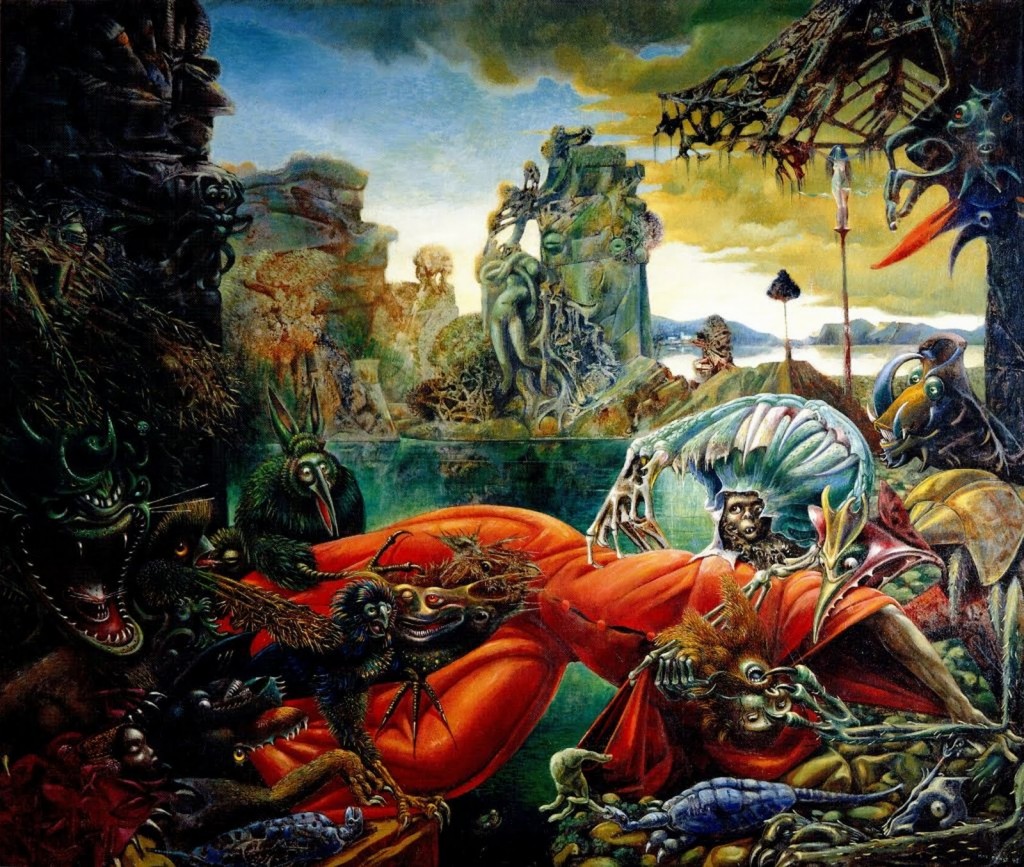
Apart from the reception of Grünewald as the spokesman of the downtrodden and suffering creature, there were also diverse ideologically charged aspects of the uses of Grünewald and his work. Around the same time when he was being hailed by expressionist artists as a forerunner and primitive (figs. 4a and 4b), art critics intent on regarding the Expressionist movement as a particularly German form of aesthetic innovation forged the link between a Gothic, Nordic, Germanic Grünewald and contemporary art. Once national socialist ideology began to dominate art history in Germany, however, Grünewald was deemed too obsessed with the sick, excessive and degenerate. After World War II, Grünewald reception in the two Germanys differed considerably. Whereas in the East he was highly regarded for his realism, his expressivity, and his focus on suffering and pain, in the West it was the apocalyptic and fantastic aspects of his art that were especially appreciated.4 In all of its conflicted and diverse aspects, the reception of Grünewald’s work has continued to be interwoven with key aspects of German history.5 As I will show, Sebald is acutely aware of this in his approach to Grünewald, presupposing a familiarity both with Grünewald’s work as well as with its artistic and scholarly reception.
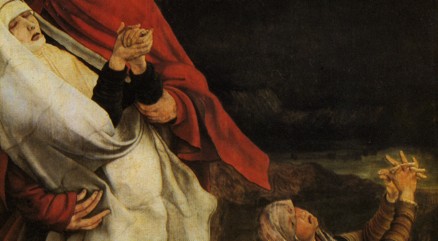
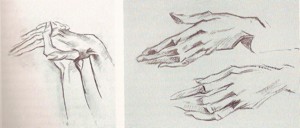
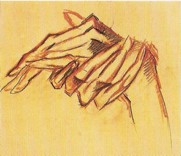
The scholarly and the artistic reception of Grünewald’s work however play different roles in Sebald’s poem. Whereas Sebald’s poem addresses explicitly various aspects of the art historical scholarship on Grünewald, especially the debates about the biographical persona of the painter, such as the question whether the hydraulic engineer Mathis Nithart and the master of the Isenheim altar Matthias Grünewald, were one and the same person, the productive reception of Grünewald’s art by other artists, recruiting him into a wide spectrum of aesthetic, stylistic and political programs ranging from realism and naturalism to symbolism and surrealism, is not thematized in the poem. Instead, the poem engages directly in the productive reception of Grünewald by meditating on the identity of the painter from the position of a late twentieth-century observer. In fact, as we shall see, in doing so the poem re-writes or undoes the accepted art historical narrative and engages with the painter and his oeuvre in order to pursue questions about the relationship between artist and work of art and about the relationship between the work of art and history.
Mimetic Encounters across Time and Space
The poem opens with the following statement:
Wer die Flügel des Altars
der Pfarrkirche von Lindenhardt
zumacht und die geschnitzten Figuren
in ihrem Gehäuse verschließt,
dem kommt auf der linken
Tafel der hl. Georg entgegen. (7)—
Whoever closes the wings
of the altar in the Lindenhardt
parish church and locks up
the carved figures in their casing
on the lefthand panel
will be met by St. George.6
The first sentence doesn’t just say what can be seen but rather what happens if one closes the altar’s left shutter and encloses the carved figures in their housing. The opening sentence invites the reader of the poem to imagine herself in front of the altar of the parish church of Lindenhardt.
This approach treats the altarpiece stripped of its religious and devotional function and thus entirely like a work of art. There are two aspects of this work of art, two forms of presence that are highlighted in the opening sentence: By emphasizing the three dimensional nature of the altar that resembles the format of a bound volume, the fact that its wings need to be closed and opened in order to be seen in its entirety, the poem begins with an emphasis on the unique physical object. The original work of art that needs to be visited in its own place is thus contrasted with the work of art in the imaginary museum of the art historically well-versed addressee, a memory that can be easily refreshed with the help of color illustrations in books or on the Internet (not in 1988, of course). Yet, while the poem draws attention to the concrete material object or vehicle of the work of art, in the same sentence it also draws attention to the imaginary aspect of the representational work of art. It is in the crossing of the threshold of representation that the encounter actually happens: the St. George that steps out of the painting to meet the beholder is not a series of lines on a flat surface (fig. 5).
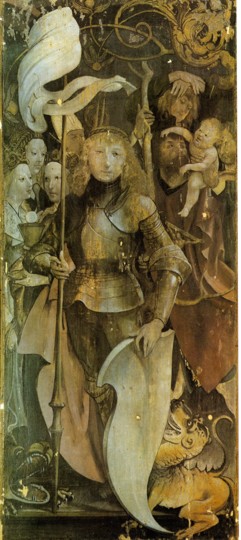
At the beginning of this poem thus stands the model of an encounter between artwork and beholder. Moreover, and this will become the key theme for the entire first part of the poem, this encounter very quickly reveals itself to be one between the beholder of a work or art and its artist. For the poem reveals how the artist has lent his own physiognomy to some of the religious subjects in his paintings:
Zuvorderst steht er am Bildrand
eine Handbreit über der Welt,
und wird gleich über die Schwelle
des Rahmens treten. Georgius Miles,
Mann mit eisernem Rumpf, erzen geründeter
Brust, rotgoldnem Haupthaar und silbernen
weiblichen Zügen. Das Antlitz des unbekannten
Grünewald taucht stets wieder auf
in seinem Werk als das eines Zeugen
des Schneewunders, eines Einsiedlers
in der Wüste, eines Mitleidigen
in der Münchner Verspottung. (7)—
Foremost at the picture’s edge he stands
above the world by a hand’s breadth
and is about to step over the frame’s
threshold. Georgius Miles,
man with the iron torso, rounded chest
of ore, red-golden hair and silver
feminine features. The face of the unknown
Grünewald emerges again and again
in his work as a witness
to the snow miracle, a hermit
in the desert, a commiserator
in the Munich Mocking of Christ. (5)
As we have seen, St. George is not introduced as a painted representation of the Saint but as if it were the Saint in person, alive and active, just about to do something, just about to step out of the painting. This aesthetic transformation is somehow related to the artist’s persona, his face and expression. Grünewald’s practice of lending his face to select subjects in his paintings was not one of inscribing himself into the religious, allegorical or historical significance of these subjects, rather it was a way for Grünewald to reflect on his own perspective. By extension, the poem marks artistic representation as a realist enterprise that works with a reference to a specific, identifiable referent (the face of the artist) but also one that is characterized by the artist’s specific outlook towards the world, a set of specific observer positions (captured by the artist’s ability to relate to suffering and misery, his ability to work like a hermit in utter isolation, and his ability to wonder at nature) (figs. 6a, 6b, and 6c).

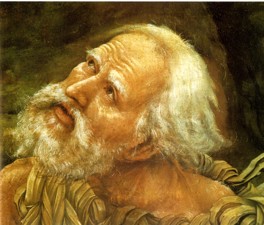
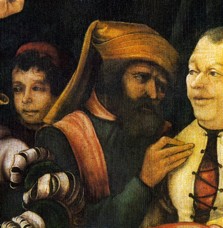
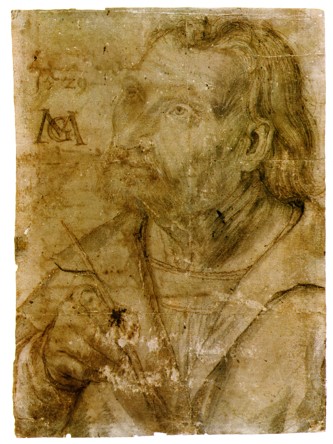
In order to support its claim that certain subjects from Grünewald’s paintings have been given the painter’s facial features the poem turns to a known self-portrait by Grünewald (fig. 7):
Zuletzt im Nachmittagsschimmer
der Erlanger Bibliothek scheint es hervor
aus einem mit weiß gehöhter Kreide angelegten,
später mit Feder und Tusche von fremder
Hand zerstörten Selbstbildnis eines vierzig bis
fünfzigjährigen Malers. Immer dieselbe
Sanftmut, dieselbe Bürde der Trübsal,
dieselbe Unregelmäßigkeit der Augen, verhängt
und versunken seitwärts ins Einsame hin. (7–8)—
Last of all, in the afternoon light
in the Erlangen library, it shines forth
from a self-portrait, sketched out
in heightened white crayon, later destroyed
by an alien hand’s pen and wash,
as that of a painter aged forty
to fifty. Always the same
gentleness, the same burden of grief,
the same irregularity of the eyes, veiled
and sliding sideways down into loneliness. (6)
Grünewald’s face here has the status of the signified of the painting, the ideational object that the beholder of the self-portrait encounters as it emerges out of the material artifact compared to the way that St. George appears to step over the picture frame. The second sentence is elliptical; it is missing a verb. Pragmatically it can be described as a deictic gesture. The modifier “always the same” (immer dieselbe) implies the speaker’s own position and affective disposition in relation to the comparison between the various Grünewald portraits. Like the first sentence of the poem, this sentence also invokes an encounter between an artwork and a beholder: in this case between Grünewald’s self-portrait in the University library of Erlangen and not the unspecified “whoever” of the opening sentence but a particular person. For without using the first person singular, the deictic gesture of the “last of all” (zuletzt) is relative to the agency speaking or writing the sentence that describes this encounter. In addition, by mentioning the quality of the light, the sentence provides an atmospheric detail that invokes an embodied presence. By making the speaker or writer of the poem into a witness, into somebody who was physically present at a specific time and place, the poem authenticates its observation about Grünewald’s representational practice.
Besides this reference to the observer of the drawing as the embodied speaker of the poem, the sentence invokes another, altogether different referential dimension. The second temporal adverb used in the subordinate clause, the “later” (später) in the form of the comparative invokes a different temporal axis. It shifts from the preceding “last of all” with its reference to the life of the speaker of the poem to the life of the drawing, its initial fabrication by the artist followed by its later defacement by an unknown hand. But the poem does not rest with these two distinct temporalities. The sentence that immediately follows leaves the reference relative to specific time lines in favor of an a-temporal presence of an “always the same” of a face expressing a gentle, melancholic disposition, lonely and burdened with sadness. Like in the initial encounter with St. George, here too it appears that the encounter takes place in the imagination of the beholder, in this case of the beholder who is writing the poem and identifying with Grünewald’s face, finding in the facial expression of the admired artist support for his own psychic disposition. In other words, the reader of this poem is presented with a glimpse of a speaker/author by way of this network of identifications and might wonder whether the St. George who initially comes out of the frame to meet the beholder also shares the appearance and disposition of the Georg hiding behind the initials W.G. Sebald.
This is not the place to pursue the question as to how much of Sebald’s own life experience has been embedded in his literary writings. It would be a mistake to read in the opening sections of After Nature a license for biographical criticism. It is more productive to recognize the programmatic aspect implied by this restoration of an authorial presence behind the work of art and to relate this gesture to the debates in literary criticism and literary theory from the 1970’s and 80’s. For the post-structuralist debates, especially, the now almost canonical reactions to what Roland Barthes’s famous essay called the “death of the author,” to which Foucault’s “What Is an Author?” but also Said’s “The World, the Text, the Critic” responded, are not to be reduced to the issue of biographical criticism. At stake in those debates were the more fundamental issues about the referential dimension of a work of art and the nature of truth claims of art and criticism. Seen in this context, Sebald’s poem, which models the art work on the corpus of a famous painter as it then engages with questions of authorship appears to go back to pre-structuralist positions to the extent that it seemingly privileges, on the one hand, the unique concrete work and the original with its own life, and, on the other hand, the beholder’s encounter with the personalized perspective of the artist or author. And yet this first impression fails to capture it all, for apart from the emphasis on the work’s unique status as an original, which produces a certain re-auratization of the art work, there is also a strong emphasis on the referential dimension of a verbal or painted picture and the artwork’s unique relationship to history.
In fact, the initial introduction of the artwork qua individual work and an artist’s life-time oeuvre is quickly checked by an analysis of the artwork qua complex text, operating with a set of codes and presenting itself as a site of inter-textual references. As such the artwork is a constantly changing set of references, open both to the past and the future for powerful actualizations and misappropriations. The artwork as a site of intertextuality is especially fore-grounded in the poem’s meditations on the artwork’s relationship to history, both, in terms of its own reception through history, including the ideological uses to which it is put, and in terms of its potential for a critique of history. What seems especially important to me in Sebald’s insistence on both aspects—the inter-textual set of references as well as the reference to a concrete material reality of specific historical events—is that he does not keep the two separate and distinct from one another but tends to bring them into intimate proximity: the fate of a set of ideas and inter-textual relations, on the one hand, and the fate of the material object, the concrete vehicle of the artwork, on the other.
Critiques and Alternatives to History: A Realist Program After Nature
Apart from referencing Grünewald’s self-portrait, the poem also cites the key scholarly source of the physiognomic approach to art history that informs the central focus for its approach to this artist:
Auch kehrt Grünewalds Gesicht wieder
in einem Basler Bild des jüngeren
Holbein, das eine gekrönte Heilige zeigt.
Es seien dies merkwürdig verstellte
Fälle von Ähnlichkeiten, schrieb Fraenger,
dessen Bücher die Faschisten verbrannten.
Ja, es scheine, als hätten im Kunstwerk
die Männer einander verehrt wie Brüder,
einander dort oft ein Denkmal gesetzt,
wo ihre Wege sich kreuzten. (8)—
Grünewald’s face reappears, too,
in a Basel painting by Holbein
the Younger of a crowned female saint.
These were strangely disguised
instances of resemblance, wrote Fraenger
whose books were burned by the fascists.
Indeed it seemed as though in such works of art
men had revered each other like brothers, and
often made monuments in each other’s
image where their paths had crossed. (6)
As the poem introduces the issue of how artists acknowledge each other, it turns to the famous historian of Renaissance art, Wilhelm Fraenger. In his Matthias Grünewald in seinen Werken: Ein physiognomischer Versuch from 1936, Fraenger traces the network of Grünewald self-portraits and portraits in order to elucidate the life and work of this artist about whom we have only very scant biographical information.7 Apart from his scholarly achievements, Fraenger has been praised for his uniquely rhythmical prose style, which this particular section of Sebald’s poem imitates.8 With this mimeticism of Fraenger, the poem practices the same kind of artistic homage it attributes to Holbein or Grünewald.
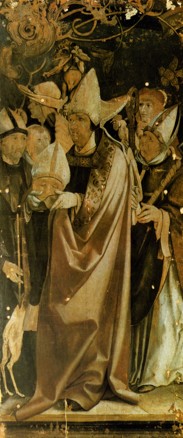
The reader might pause at the passage quoted above and wonder how there could be mutual admiration (“einander verehrt”) and love between artists who lived in such disparate historical times? How is it possible for their paths ever to have crossed? And yet this is exactly what the poem proceeds to argue in the lines immediately following. Indeed, what follows could be characterized as the mis-en-scène of this crossing of paths as a complex scene of recognition, a sharing of glances and lending of faces (fig. 8):
auch in der Mitte des rechten Flügels
des Lindenhardter Altars in Besorgnis
den Blick auf den Jüngling auf der anderen
Seite gerichtet jener ältere Mann, dem ich selber
vor Jahren einmal an einem Januarmorgen
auf dem Bamberger Bahnhof begegnet bin.
Es ist der heilige Dionysus,
das abgeschlagene Haupt unterm Arm.
Ihm, seinem erwählten Protektor,
der inmitten des Lebens seinen Tod
mit sich führt, gibt Grünewald das Ansehen
Riemenschneiders, dem der Würzburger Bischof
zwanzig Jahre darauf auf der Folter
die Hände zerbrechen ließ. Lang vor der Zeit
geht der Schmerz bereits ein in die Bilder. (8)—
Hence too, at the centre of
the Lindenhardt altar’s right wing,
that troubled gaze upon the youth
on the other side of the older man
whom, years ago now, on a grey
January morning I myself once
encountered in the railway station
in Bamberg. It is St. Dionysius,
his cut-off head under one arm.
To him, his chosen guardian
who in the midst of life carries
his death with him, Grünewald gives
the appearance of Riemenschneider, whom
twenty years later the Würzburg bishop
condemned to the breaking of his hands
in the torture cell. Long before that time
pain had entered into the pictures. (6–7)
The speaker of the poem claims that the young man in Grünewald’s painting is the same man that he had met at the railway station in Bamberg years ago on a January morning. How, one might wonder, is he able to claim that he met a figure from a painting more than four hundred years old? Surely, he can mean that only in terms of the similarity of the look, that worried concern of an older man for a younger man. But no, he claims that he actually met St. Dionysus, Grünewald’s patron saint and protector to whom Grünewald had given the face of a much admired and beloved older artist colleague, the sculptor Riemenschneider. And why did Grünewald give Riemenschneider’s face to St. Dionysus? The personal union between the saint and the sculptor, according to the poem, lies in their relationship to suffering and death. Dionysus was beheaded and is traditionally represented as carrying his head both on his shoulders and under his arm. This iconographic convention of identifying martyrs by their specific martyrdom is then transferred to Riemenschneider, who thus also becomes a martyr when we are told that works of art are distinguished by an anticipatory relationship to the infliction of pain and moreover, that art’s extreme sensitivity to suffering has the power to unite artists across the ages.
Though the poem does not claim that art can predict the future, it nevertheless attributes to art an ability to register pain long before it is inflicted. And yet, the reader might ask how the painter Grünewald should have known that Riemenschneider was to be tortured on behalf of the bishop of Bamberg. What does this mean? As if anticipating exactly that question the poem continues:
Das ist die Vorschrift, weiß der Maler,
der sich einreiht auf dem Altar
in die viel zu geringe Genossenschaft
der vierzehn Nothelfer. (8)—
That is the command, knows the painter
who on the altar aligns himself
with the scant company of the
fourteen auxiliary saints. (7)
The rule or command (Vorschrift) that the painter knows is the one just mentioned, namely that pain enters into paintings long before it is actually inflicted. And the fact that the painter lends his own face to St. George means that Grünewald, according to Sebald, makes himself into a figure that carries his death already with him during his life. Sainthood is not defined by a particularly virtuous and religious life and by the ability to perform miracles but rather by a relationship to pain and suffering and to one’s own death: indeed, in the penultimate and final sections of the Grünewald part, the poem returns to this claim by showing the mimetic resemblance between both Grünewald’s reaction to the slaughter during the peasant wars in 1525 and by depicting his own death as a form of blindness.
Whereas Sebald’s approach to Fraenger could be characterized as homage, as an admiring, identificatory, at times mimetic approach, this attitude is far from universal. On the contrary, Sebald also calls for a critical use of one’s sources. This becomes clear in the contrast between the poem’s attitude towards Grünewald’s first biographer, the baroque scholar and artist Joachim von Sandrart, on the one hand, and its stance towards Fraenger’s contemporary, the art historian Walter Karl Zülch, on the other. Whereas the poet’s love for the baroque scholar is expressed in the mimicry of Sandrart’s language, his lexical choices, even his spelling, those features of Zülch’s work are not imitated but analyzed and criticized. As we learn, the preface to Zülch’s biographical study of Grünewald is dated April 20, 1938, indicating that the book appeared on Hitler’s birthday. And, as the poem goes on to suggest, the choice of font likewise reflects the author’s pandering to Nazi sensibilities (fig. 9).
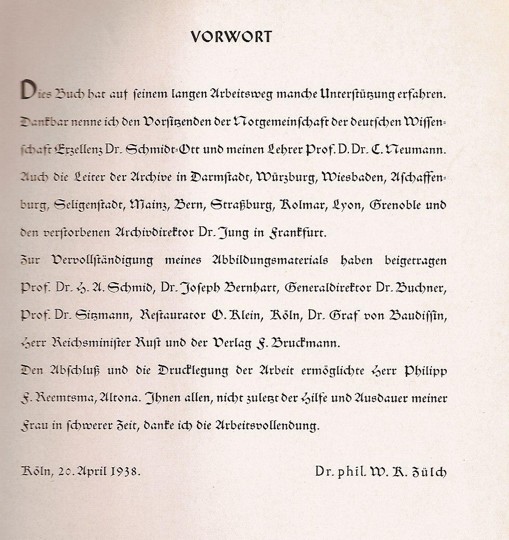
Although most Grünewald scholars have come to accept the biographical identity of the painter known as Matthias Grünewald with the draftsman, painter and hydraulic engineer known as Mathis Nithart, Sebald’s poem argues that Nithart and Matthias Grünewald were not the same person but loving, most intimate friends and collaborators instead:
Und in der Tat geht die Figur des Mathis Nithart
in den Dokumenten der Zeit in einem Maß
in die Grünewalds über, daß man meint,
der eine habe wirklich das Leben
und zuletzt gar den Tod
des anderen ausgemacht.
Eine Röntgenaufnahme der Sebastianstafel
bringt hinter dem elegischen Portrait
des Heiligen nochmals dasselbe Gesicht
zum Vorschein, das Halbprofil
in der endgültigen Übermalung nur
um ein winziges weiter gewendet.
Hier haben zwei Maler in einem Körper,
dessen verletztes Fleisch ihnen beiden gehörte,
ihre Natur ausstudiert. Zuerst hat Nithart
aus dem Spiegel sein eignes Bildnis
gefertigt, und Grünewald hat es dann
mit großer Liebe, Genauigkeit und Geduld
und einem bis in die blauen Bartschatten
hineingehenden Interesse an der Haut
und am Haar seines Genossen übermalt. (17)—
And indeed the person of Mathis Nithart
in documents of the time so flows into
the person of Grünewald that one
seems to have been the life,
then the death, too, of the other.
An X-ray photograph of the Sebastian panel
reveals beneath the elegiac
portrait of the saint
that same face again, the half-
profile only turned a tiny bit further
in the definitive overpainting.
Here two painters in one body
whose hurt flesh belonged to both
to the end pursued the study
of their own nature. At first
Nithart fashioned his self-portrait
from a mirror image, and Grünewald
with great love, precision and patience
and an interest in the skin
and hair of his companion extending
to the blue shadow of the beard
then overpainted it. (18–19)
Art historians have discovered that the face of St. Sebastian (fig. 10) is in fact painted on top of another, identical face, turned just slightly less to the side. There has been some debate among Grünewald scholars as to whether or not the face of St. Sebastian is also a Grünewald self-portrait or whether it might be a portrait of a younger student of his.9 Sebald’s poem presents another thesis altogether: the first portrait was a self-portrait produced by Nithart as he was looking into the mirror, thus accounting for the slight turn of the head. Grünewald then supposedly took his friend’s portrait and adjusted the angle slightly to produce the final image of St. Sebastian. The result of painting over that original portrait thus appears as the document of a loving, erotic union between the two men. Saint Sebastian’s martyrdom becomes “the representation of a male friendship, horrified and loyal, still palpable at the ridges of the wounds.” Nithart’s death and will, which in art historical scholarship has been used as an important document confirming the identity of the two men, is also reinterpreted: Nithart became the public face for the shy Grünewald, but the two men did not die the same death. Nithart died in Frankfurt in 1528, the same year as Grünewald. By recounting Nithart’s and Grünewald’s deaths separately, however, the poem reinforces the impression that we are dealing with two distinct biographical identities.

If this poem offers alternative accounts of Grünewald’s biographical identity, it does so not in the service of providing a better or more comprehensive narrative of Grünewald’s life. Indeed, it is important to stress that throughout the Grünewald section there are only very few linear narratives. Even the section that mentions Grünewald’s marriage to the young Jewish girl from the Ghetto, her conversion to Christianity and her institutionalization in a lunatic asylum, in the context of the speculation that she might have become so insufferably unhappy and belligerent because her husband had not paid enough attention to her, is much less a narrative than a citation of narratives that holds epic practice in abeyance, at a critical, ironic, ambivalent distance. This is how the third section commences, evoking the “epic sound” through its repeated use of hexameter:
Lang ist bekanntlich die Tradition
der Verfolgung der Juden, auch
in der Stadt Frankfurt am Main.
Um 1240 sollen 173 von ihnen
theils erschlagen worden, theils
eines freiwilligen Todes in den Flammen
gestorben sein. Im Jahr 1349
machten die Geiselbrüder ein großes
Massaker im Judenquartier. Wieder
besagen die Berichte, daß die Juden
sich selber verbrannt hätten
und es nach der Feuersbrunst
möglich gewesen sei, vom Domhügel
bis nach Sachsenhausen zu sehen. (12)—
We know there is a long tradition
of persecuting the Jews, in the City
of Frankfurt as in other places.
Around 1240, the records tell us,
173 were either slaughtered
or died of their own free will
in a conflagration. In 1349
the Flagellant Brothers instituted
a great massacre in the Jewish quarter.
Again, the chronicles tell that the Jews
burned themselves and that
after the fire there was a clear view from
the Cathedral Hill over to Sachsenhausen. (12)
By introducing the history of anti-Semitic pogroms as if this were something of a long, heroic tradition, the three laconic sentences call our attention to the complicity of the reports with the actual pogroms. They achieve this by “quoting” the partial denial of the murder through the assertion that some Jews had voluntarily chosen to be burned to death, then by calling the reader’s attention to the repetitive nature of that absurd claim, which makes the denial of the extent of the violence part of its long tradition. While the poem attends to both, the history of violence as well as its reporting, it also marks its own distance towards these representational practices.
The style, tone, and manner of representing historical events is itself part of history and bears historical responsibility. Realist art, to the extent that it engages with historical events, shares this responsibility in terms of how it depicts violence, pain, and suffering. It may do so by adopting a critical approach to historical sources, but also by bringing out the contingency of historical events and by imagining how it might have been otherwise. Art’s critical stance towards history, as developed in the opening sections of Sebald’s poem, can be summarized as follows: the artwork is bound up with history, it doesn’t stand outside or above it, but it must not be defined by it or reduced to one narrow historical context. The artwork can transcend its own historical horizon in the manner in which it participates in, cites, and engages with other works of art and thus forms a network of intertextual relations open to the past and the future.
This characterization of art’s critical potential, however, would be insufficient without commenting on the phrase “after nature” (nach der Natur), which both serves as the title of Sebald’s poem and is used in some key phrases. When we use the phrase to paint after nature (nach der Natur), we generally mean it in opposition to the “imitation of art”. This is also true of Sebald’s use of the phrase, but his inflection can be further specified: it does not only mean a realist or naturalist bent in opposition to an idealizing bent, but it also means a certain devotion to nature and an understanding of the artistic, creative process as part of nature. This latter aspect if explored in much greater detail in the section on the explorer and naturalist Steller. In the Grünewald section it is used to characterize the painter’s representational style as a realist enterprise devoid of both religious promises as well as utopian political aspirations. The poem introduces the phrase in the context of Grünewald’s depiction of the apocalyptic landscape from the Basel crucifixion and asserts that that scene is painted “from nature” (in German: “nach der Natur”), meaning that it is based on a perfectly natural experience, the painter’s view of the solar eclipse of 1502.
The poem’s affirmation of realist aesthetics is further elaborated vis-à-vis Grünewald’s critique of chiliastic hopes and religiously inspired apocalyptic visions, in the passages dealing with Thomas Müntzer and the peasant rebellion of 1525. This pessimistic and at the same time critical stance toward history is, of course, familiar to us from Sebald’s other works. What I wish to stress here, however, is how this text also affirms the artist’s loving devotion to realist detail, the depiction of highly individualized subjects as a loving re-investment in the world. This means that the artist must not be entirely consumed by the depiction of violence, suffering, and destruction, but can also preserve the ability to realize beauty in nature. As if to make a point that Grünewald’s deeply empathetic response to learning about the peasant massacre, which consisted in blindfolding and secluding himself, must not be the artist’s last gesture, that he cannot just stop painting and enter a world of self-imposed darkness and depression, the poem includes a short narrative about the painter’s ride through a landscape with his only child, whom he has begun to teach. This last landscape description in the Grünewald section is entirely devoid of any metaphysical overtones or allegorical interpretation and it is also the only real landscape rather than painted landscape that this part of the poem actually describes. It appears that in spite of all of the previous despair, here the purely aesthetic, momentary experience of a beautiful nature, the play of the light and shadow in the branches as father and child ride through the early autumnal afternoon is possible. Here, after all of the monstrosity and suffering, this brief, in itself insignificant enjoyment of a beautiful nature seems like a gesture of defiance.
And yet, the poem After Nature also insists that the view into the landscape is not to be mistaken as an escape into an idyll. For this scenario, the view of a landscape following the description of utter destruction and violence recurs in the poem repeatedly beginning with the view into the landscape from the cathedral hill to Sachsenhausen that concludes the passage about the pogroms in Frankfurt, Grünewald’s seemingly otherworldly landscapes, such as the crucifixion at Basel or the snow miracle, the poem’s description of Grünewald’s ride through an idyllic landscape after the massacre of the peasants, Steller’s encounter with the wild beauty of the Pacific Northwest after the ravaging scurvy and destruction on board his ship. This series of juxtaposed scenes of destruction and violence followed by views of a beautiful nature culminates in the poem’s concluding image, which describes the poet’s dream of flying across the channel and Germany to Munich at night in order to visit a painting. The point is simple: the experience of the beautiful landscape is not an alternative to dealing with the reality of war, violence, and suffering, but is embedded in the bigger picture. Art, in short, records beauty along with violence and destruction. Finally, art, according to Sebald, both the artist and the physical object of art, the printed page, the drawing or the altarpiece, are all utterly historical and datable. In that aspect art has the position and function of a witness. But it can also transcend any one specific historical context through the complex web of inter-textual borrowings and loans, homages, appropriations, and misappropriations. And it is in that sense art can and must transcend history.
Notes
W.G. Sebald’s long poem Nach der Natur (1988) contributed significantly to the swift recognition of his literary talent among fellow writers and poets, yet it received scant attention by the larger public and literary scholars alike.1 To the English-speaking world it was not even available until 2002, a year after its author’s death, when it appeared in Michael Hamburger’s excellent translation under the title After Nature. Like a triptych, it is divided into three untitled parts, each with a distinct thematic concern involving a specific historical period and a writer or artist: the first focuses on the Renaissance painter Matthias Grünewald, the second on the eighteenth-century naturalist, travel writer, and Arctic explorer Georg Wilhelm Steller, and the last on elements from Sebald’s own biography.2 As opposed to Sebald’s later practice, apart from the landscape photographs that are reproduced on the end sheets of the first edition of Nach der Natur, there are no visuals in the volume, although paintings play a prominent role, especially in the first and final sections of the poem. In what follows, I shall support my reading of Sebald’s poem with reproductions of Grünewald’s paintings. I do so, however, in an attempt to provide a glossary, and I do not want to confuse this with Sebald’s own, later practice of including visuals in his texts.
What fascinates me in this early poem by Sebald is its poetological dimension, the manner in which it provides a sustained reflection on the material aspects of the work of art and on the nature of art in its relationship to history. Moreover, what makes these meditations particularly interesting is their un-timeliness, their departure from what were then especially among literary scholars dominant critical clichés and pious practices, such as the presumed death of the author or the reduction of works of art to their historical contexts. For when he composed Nach der Natur in the late 1980’s, Sebald was a literary scholar and a professor of German Literature at the University of East Anglia in the United Kingdom, specializing in Realism and the literature of the nineteenth- and twentieth-centuries. In that sense one could ascribe a certain autobiographical dimension to this prose poem and read it as a reflection on crossing the threshold of the world of the academic and scholar into the world of artistic production. However, I shall only touch on this autobiographical dimension to the extent that I shall explore how Sebald makes use of another artist, Grünewald, in order to explore the way in which artists give their own face to their work and the way in which they borrow the faces of other artists as an acknowledgement of admiration and influence. Thus I shall focus on the poem’s first part and show how Sebald reflects on Grünewald: the oeuvre, the artist, and the historical persona, but also art historical scholarship about Grünewald.




Before approaching Sebald’s meditations on Matthias Grünewald (c.1470-1528), a few remarks about the reception of Grünewald’s work are in order. For the first three centuries after his death, this Renaissance artist did not attract much attention. But around 1900 the French writer Joris-Karl Huysmans made a passionate plea for the relevance and modernity of Grünewald. In his description of the altar at Isenheim, Huysmans called attention to Grünewald’s shocking insistence on the physical details of Christ’s suffering, alerting its beholder to the disgusting marks of torture and the signs of dying and decomposing flesh (figs. 1a and 1b). Such a Christ, Huysmans observed, is no longer the well-groomed, handsome man who has been venerated by the rich and powerful throughout the ages. Grünewald’s Christ is rather the “God of the Poor. The one who chose the company of those in misery and of those who had been rejected, of all those for whose ugliness and need the world could only feel contempt.”3 And it was exactly this approach to pain and suffering highlighted by Huysmans that subsequently became a point of reference for many artists who invoked Grünewald’s work, especially when they cited the triptych from the Isenheim altarpiece or The Mockery of Christ (fig. 2) from the Alte Pinakothek in Munich. Otto Dix and Max Ernst in particular made specific reference to the altarpiece from Isenheim in their works depicting the suffering and destruction wrought by World War I and II (figs. 3a and 3b). Empathy with the suffering as well as the willingness to pay attention to all aspects of pain, decay, and death will also become an important concern for Sebald’s poem, albeit, as we shall see, not through any direct focus on the depiction of the crucified but only in view of the other figures from Grünewald’s work: the bystanders, witnesses, and patron saints.



Apart from the reception of Grünewald as the spokesman of the downtrodden and suffering creature, there were also diverse ideologically charged aspects of the uses of Grünewald and his work. Around the same time when he was being hailed by expressionist artists as a forerunner and primitive (figs. 4a and 4b), art critics intent on regarding the Expressionist movement as a particularly German form of aesthetic innovation forged the link between a Gothic, Nordic, Germanic Grünewald and contemporary art. Once national socialist ideology began to dominate art history in Germany, however, Grünewald was deemed too obsessed with the sick, excessive and degenerate. After World War II, Grünewald reception in the two Germanys differed considerably. Whereas in the East he was highly regarded for his realism, his expressivity, and his focus on suffering and pain, in the West it was the apocalyptic and fantastic aspects of his art that were especially appreciated.4 In all of its conflicted and diverse aspects, the reception of Grünewald’s work has continued to be interwoven with key aspects of German history.5 As I will show, Sebald is acutely aware of this in his approach to Grünewald, presupposing a familiarity both with Grünewald’s work as well as with its artistic and scholarly reception.



The scholarly and the artistic reception of Grünewald’s work however play different roles in Sebald’s poem. Whereas Sebald’s poem addresses explicitly various aspects of the art historical scholarship on Grünewald, especially the debates about the biographical persona of the painter, such as the question whether the hydraulic engineer Mathis Nithart and the master of the Isenheim altar Matthias Grünewald, were one and the same person, the productive reception of Grünewald’s art by other artists, recruiting him into a wide spectrum of aesthetic, stylistic and political programs ranging from realism and naturalism to symbolism and surrealism, is not thematized in the poem. Instead, the poem engages directly in the productive reception of Grünewald by meditating on the identity of the painter from the position of a late twentieth-century observer. In fact, as we shall see, in doing so the poem re-writes or undoes the accepted art historical narrative and engages with the painter and his oeuvre in order to pursue questions about the relationship between artist and work of art and about the relationship between the work of art and history.
Mimetic Encounters across Time and Space
The poem opens with the following statement:
Wer die Flügel des Altars
der Pfarrkirche von Lindenhardt
zumacht und die geschnitzten Figuren
in ihrem Gehäuse verschließt,
dem kommt auf der linken
Tafel der hl. Georg entgegen. (7)—
Whoever closes the wings
of the altar in the Lindenhardt
parish church and locks up
the carved figures in their casing
on the lefthand panel
will be met by St. George.6
The first sentence doesn’t just say what can be seen but rather what happens if one closes the altar’s left shutter and encloses the carved figures in their housing. The opening sentence invites the reader of the poem to imagine herself in front of the altar of the parish church of Lindenhardt.
This approach treats the altarpiece stripped of its religious and devotional function and thus entirely like a work of art. There are two aspects of this work of art, two forms of presence that are highlighted in the opening sentence: By emphasizing the three dimensional nature of the altar that resembles the format of a bound volume, the fact that its wings need to be closed and opened in order to be seen in its entirety, the poem begins with an emphasis on the unique physical object. The original work of art that needs to be visited in its own place is thus contrasted with the work of art in the imaginary museum of the art historically well-versed addressee, a memory that can be easily refreshed with the help of color illustrations in books or on the Internet (not in 1988, of course). Yet, while the poem draws attention to the concrete material object or vehicle of the work of art, in the same sentence it also draws attention to the imaginary aspect of the representational work of art. It is in the crossing of the threshold of representation that the encounter actually happens: the St. George that steps out of the painting to meet the beholder is not a series of lines on a flat surface (fig. 5).

At the beginning of this poem thus stands the model of an encounter between artwork and beholder. Moreover, and this will become the key theme for the entire first part of the poem, this encounter very quickly reveals itself to be one between the beholder of a work or art and its artist. For the poem reveals how the artist has lent his own physiognomy to some of the religious subjects in his paintings:
Zuvorderst steht er am Bildrand
eine Handbreit über der Welt,
und wird gleich über die Schwelle
des Rahmens treten. Georgius Miles,
Mann mit eisernem Rumpf, erzen geründeter
Brust, rotgoldnem Haupthaar und silbernen
weiblichen Zügen. Das Antlitz des unbekannten
Grünewald taucht stets wieder auf
in seinem Werk als das eines Zeugen
des Schneewunders, eines Einsiedlers
in der Wüste, eines Mitleidigen
in der Münchner Verspottung. (7)—
Foremost at the picture’s edge he stands
above the world by a hand’s breadth
and is about to step over the frame’s
threshold. Georgius Miles,
man with the iron torso, rounded chest
of ore, red-golden hair and silver
feminine features. The face of the unknown
Grünewald emerges again and again
in his work as a witness
to the snow miracle, a hermit
in the desert, a commiserator
in the Munich Mocking of Christ. (5)
As we have seen, St. George is not introduced as a painted representation of the Saint but as if it were the Saint in person, alive and active, just about to do something, just about to step out of the painting. This aesthetic transformation is somehow related to the artist’s persona, his face and expression. Grünewald’s practice of lending his face to select subjects in his paintings was not one of inscribing himself into the religious, allegorical or historical significance of these subjects, rather it was a way for Grünewald to reflect on his own perspective. By extension, the poem marks artistic representation as a realist enterprise that works with a reference to a specific, identifiable referent (the face of the artist) but also one that is characterized by the artist’s specific outlook towards the world, a set of specific observer positions (captured by the artist’s ability to relate to suffering and misery, his ability to work like a hermit in utter isolation, and his ability to wonder at nature) (figs. 6a, 6b, and 6c).




In order to support its claim that certain subjects from Grünewald’s paintings have been given the painter’s facial features the poem turns to a known self-portrait by Grünewald (fig. 7):
Zuletzt im Nachmittagsschimmer
der Erlanger Bibliothek scheint es hervor
aus einem mit weiß gehöhter Kreide angelegten,
später mit Feder und Tusche von fremder
Hand zerstörten Selbstbildnis eines vierzig bis
fünfzigjährigen Malers. Immer dieselbe
Sanftmut, dieselbe Bürde der Trübsal,
dieselbe Unregelmäßigkeit der Augen, verhängt
und versunken seitwärts ins Einsame hin. (7–8)—
Last of all, in the afternoon light
in the Erlangen library, it shines forth
from a self-portrait, sketched out
in heightened white crayon, later destroyed
by an alien hand’s pen and wash,
as that of a painter aged forty
to fifty. Always the same
gentleness, the same burden of grief,
the same irregularity of the eyes, veiled
and sliding sideways down into loneliness. (6)
Grünewald’s face here has the status of the signified of the painting, the ideational object that the beholder of the self-portrait encounters as it emerges out of the material artifact compared to the way that St. George appears to step over the picture frame. The second sentence is elliptical; it is missing a verb. Pragmatically it can be described as a deictic gesture. The modifier “always the same” (immer dieselbe) implies the speaker’s own position and affective disposition in relation to the comparison between the various Grünewald portraits. Like the first sentence of the poem, this sentence also invokes an encounter between an artwork and a beholder: in this case between Grünewald’s self-portrait in the University library of Erlangen and not the unspecified “whoever” of the opening sentence but a particular person. For without using the first person singular, the deictic gesture of the “last of all” (zuletzt) is relative to the agency speaking or writing the sentence that describes this encounter. In addition, by mentioning the quality of the light, the sentence provides an atmospheric detail that invokes an embodied presence. By making the speaker or writer of the poem into a witness, into somebody who was physically present at a specific time and place, the poem authenticates its observation about Grünewald’s representational practice.
Besides this reference to the observer of the drawing as the embodied speaker of the poem, the sentence invokes another, altogether different referential dimension. The second temporal adverb used in the subordinate clause, the “later” (später) in the form of the comparative invokes a different temporal axis. It shifts from the preceding “last of all” with its reference to the life of the speaker of the poem to the life of the drawing, its initial fabrication by the artist followed by its later defacement by an unknown hand. But the poem does not rest with these two distinct temporalities. The sentence that immediately follows leaves the reference relative to specific time lines in favor of an a-temporal presence of an “always the same” of a face expressing a gentle, melancholic disposition, lonely and burdened with sadness. Like in the initial encounter with St. George, here too it appears that the encounter takes place in the imagination of the beholder, in this case of the beholder who is writing the poem and identifying with Grünewald’s face, finding in the facial expression of the admired artist support for his own psychic disposition. In other words, the reader of this poem is presented with a glimpse of a speaker/author by way of this network of identifications and might wonder whether the St. George who initially comes out of the frame to meet the beholder also shares the appearance and disposition of the Georg hiding behind the initials W.G. Sebald.
This is not the place to pursue the question as to how much of Sebald’s own life experience has been embedded in his literary writings. It would be a mistake to read in the opening sections of After Nature a license for biographical criticism. It is more productive to recognize the programmatic aspect implied by this restoration of an authorial presence behind the work of art and to relate this gesture to the debates in literary criticism and literary theory from the 1970’s and 80’s. For the post-structuralist debates, especially, the now almost canonical reactions to what Roland Barthes’s famous essay called the “death of the author,” to which Foucault’s “What Is an Author?” but also Said’s “The World, the Text, the Critic” responded, are not to be reduced to the issue of biographical criticism. At stake in those debates were the more fundamental issues about the referential dimension of a work of art and the nature of truth claims of art and criticism. Seen in this context, Sebald’s poem, which models the art work on the corpus of a famous painter as it then engages with questions of authorship appears to go back to pre-structuralist positions to the extent that it seemingly privileges, on the one hand, the unique concrete work and the original with its own life, and, on the other hand, the beholder’s encounter with the personalized perspective of the artist or author. And yet this first impression fails to capture it all, for apart from the emphasis on the work’s unique status as an original, which produces a certain re-auratization of the art work, there is also a strong emphasis on the referential dimension of a verbal or painted picture and the artwork’s unique relationship to history.
In fact, the initial introduction of the artwork qua individual work and an artist’s life-time oeuvre is quickly checked by an analysis of the artwork qua complex text, operating with a set of codes and presenting itself as a site of inter-textual references. As such the artwork is a constantly changing set of references, open both to the past and the future for powerful actualizations and misappropriations. The artwork as a site of intertextuality is especially fore-grounded in the poem’s meditations on the artwork’s relationship to history, both, in terms of its own reception through history, including the ideological uses to which it is put, and in terms of its potential for a critique of history. What seems especially important to me in Sebald’s insistence on both aspects—the inter-textual set of references as well as the reference to a concrete material reality of specific historical events—is that he does not keep the two separate and distinct from one another but tends to bring them into intimate proximity: the fate of a set of ideas and inter-textual relations, on the one hand, and the fate of the material object, the concrete vehicle of the artwork, on the other.
Critiques and Alternatives to History: A Realist Program After Nature
Apart from referencing Grünewald’s self-portrait, the poem also cites the key scholarly source of the physiognomic approach to art history that informs the central focus for its approach to this artist:
Auch kehrt Grünewalds Gesicht wieder
in einem Basler Bild des jüngeren
Holbein, das eine gekrönte Heilige zeigt.
Es seien dies merkwürdig verstellte
Fälle von Ähnlichkeiten, schrieb Fraenger,
dessen Bücher die Faschisten verbrannten.
Ja, es scheine, als hätten im Kunstwerk
die Männer einander verehrt wie Brüder,
einander dort oft ein Denkmal gesetzt,
wo ihre Wege sich kreuzten. (8)—
Grünewald’s face reappears, too,
in a Basel painting by Holbein
the Younger of a crowned female saint.
These were strangely disguised
instances of resemblance, wrote Fraenger
whose books were burned by the fascists.
Indeed it seemed as though in such works of art
men had revered each other like brothers, and
often made monuments in each other’s
image where their paths had crossed. (6)
As the poem introduces the issue of how artists acknowledge each other, it turns to the famous historian of Renaissance art, Wilhelm Fraenger. In his Matthias Grünewald in seinen Werken: Ein physiognomischer Versuch from 1936, Fraenger traces the network of Grünewald self-portraits and portraits in order to elucidate the life and work of this artist about whom we have only very scant biographical information.7 Apart from his scholarly achievements, Fraenger has been praised for his uniquely rhythmical prose style, which this particular section of Sebald’s poem imitates.8 With this mimeticism of Fraenger, the poem practices the same kind of artistic homage it attributes to Holbein or Grünewald.

The reader might pause at the passage quoted above and wonder how there could be mutual admiration (“einander verehrt”) and love between artists who lived in such disparate historical times? How is it possible for their paths ever to have crossed? And yet this is exactly what the poem proceeds to argue in the lines immediately following. Indeed, what follows could be characterized as the mis-en-scène of this crossing of paths as a complex scene of recognition, a sharing of glances and lending of faces (fig. 8):
auch in der Mitte des rechten Flügels
des Lindenhardter Altars in Besorgnis
den Blick auf den Jüngling auf der anderen
Seite gerichtet jener ältere Mann, dem ich selber
vor Jahren einmal an einem Januarmorgen
auf dem Bamberger Bahnhof begegnet bin.
Es ist der heilige Dionysus,
das abgeschlagene Haupt unterm Arm.
Ihm, seinem erwählten Protektor,
der inmitten des Lebens seinen Tod
mit sich führt, gibt Grünewald das Ansehen
Riemenschneiders, dem der Würzburger Bischof
zwanzig Jahre darauf auf der Folter
die Hände zerbrechen ließ. Lang vor der Zeit
geht der Schmerz bereits ein in die Bilder. (8)—
Hence too, at the centre of
the Lindenhardt altar’s right wing,
that troubled gaze upon the youth
on the other side of the older man
whom, years ago now, on a grey
January morning I myself once
encountered in the railway station
in Bamberg. It is St. Dionysius,
his cut-off head under one arm.
To him, his chosen guardian
who in the midst of life carries
his death with him, Grünewald gives
the appearance of Riemenschneider, whom
twenty years later the Würzburg bishop
condemned to the breaking of his hands
in the torture cell. Long before that time
pain had entered into the pictures. (6–7)
The speaker of the poem claims that the young man in Grünewald’s painting is the same man that he had met at the railway station in Bamberg years ago on a January morning. How, one might wonder, is he able to claim that he met a figure from a painting more than four hundred years old? Surely, he can mean that only in terms of the similarity of the look, that worried concern of an older man for a younger man. But no, he claims that he actually met St. Dionysus, Grünewald’s patron saint and protector to whom Grünewald had given the face of a much admired and beloved older artist colleague, the sculptor Riemenschneider. And why did Grünewald give Riemenschneider’s face to St. Dionysus? The personal union between the saint and the sculptor, according to the poem, lies in their relationship to suffering and death. Dionysus was beheaded and is traditionally represented as carrying his head both on his shoulders and under his arm. This iconographic convention of identifying martyrs by their specific martyrdom is then transferred to Riemenschneider, who thus also becomes a martyr when we are told that works of art are distinguished by an anticipatory relationship to the infliction of pain and moreover, that art’s extreme sensitivity to suffering has the power to unite artists across the ages.
Though the poem does not claim that art can predict the future, it nevertheless attributes to art an ability to register pain long before it is inflicted. And yet, the reader might ask how the painter Grünewald should have known that Riemenschneider was to be tortured on behalf of the bishop of Bamberg. What does this mean? As if anticipating exactly that question the poem continues:
Das ist die Vorschrift, weiß der Maler,
der sich einreiht auf dem Altar
in die viel zu geringe Genossenschaft
der vierzehn Nothelfer. (8)—
That is the command, knows the painter
who on the altar aligns himself
with the scant company of the
fourteen auxiliary saints. (7)
The rule or command (Vorschrift) that the painter knows is the one just mentioned, namely that pain enters into paintings long before it is actually inflicted. And the fact that the painter lends his own face to St. George means that Grünewald, according to Sebald, makes himself into a figure that carries his death already with him during his life. Sainthood is not defined by a particularly virtuous and religious life and by the ability to perform miracles but rather by a relationship to pain and suffering and to one’s own death: indeed, in the penultimate and final sections of the Grünewald part, the poem returns to this claim by showing the mimetic resemblance between both Grünewald’s reaction to the slaughter during the peasant wars in 1525 and by depicting his own death as a form of blindness.
Whereas Sebald’s approach to Fraenger could be characterized as homage, as an admiring, identificatory, at times mimetic approach, this attitude is far from universal. On the contrary, Sebald also calls for a critical use of one’s sources. This becomes clear in the contrast between the poem’s attitude towards Grünewald’s first biographer, the baroque scholar and artist Joachim von Sandrart, on the one hand, and its stance towards Fraenger’s contemporary, the art historian Walter Karl Zülch, on the other. Whereas the poet’s love for the baroque scholar is expressed in the mimicry of Sandrart’s language, his lexical choices, even his spelling, those features of Zülch’s work are not imitated but analyzed and criticized. As we learn, the preface to Zülch’s biographical study of Grünewald is dated April 20, 1938, indicating that the book appeared on Hitler’s birthday. And, as the poem goes on to suggest, the choice of font likewise reflects the author’s pandering to Nazi sensibilities (fig. 9).

Although most Grünewald scholars have come to accept the biographical identity of the painter known as Matthias Grünewald with the draftsman, painter and hydraulic engineer known as Mathis Nithart, Sebald’s poem argues that Nithart and Matthias Grünewald were not the same person but loving, most intimate friends and collaborators instead:
Und in der Tat geht die Figur des Mathis Nithart
in den Dokumenten der Zeit in einem Maß
in die Grünewalds über, daß man meint,
der eine habe wirklich das Leben
und zuletzt gar den Tod
des anderen ausgemacht.
Eine Röntgenaufnahme der Sebastianstafel
bringt hinter dem elegischen Portrait
des Heiligen nochmals dasselbe Gesicht
zum Vorschein, das Halbprofil
in der endgültigen Übermalung nur
um ein winziges weiter gewendet.
Hier haben zwei Maler in einem Körper,
dessen verletztes Fleisch ihnen beiden gehörte,
ihre Natur ausstudiert. Zuerst hat Nithart
aus dem Spiegel sein eignes Bildnis
gefertigt, und Grünewald hat es dann
mit großer Liebe, Genauigkeit und Geduld
und einem bis in die blauen Bartschatten
hineingehenden Interesse an der Haut
und am Haar seines Genossen übermalt. (17)—
And indeed the person of Mathis Nithart
in documents of the time so flows into
the person of Grünewald that one
seems to have been the life,
then the death, too, of the other.
An X-ray photograph of the Sebastian panel
reveals beneath the elegiac
portrait of the saint
that same face again, the half-
profile only turned a tiny bit further
in the definitive overpainting.
Here two painters in one body
whose hurt flesh belonged to both
to the end pursued the study
of their own nature. At first
Nithart fashioned his self-portrait
from a mirror image, and Grünewald
with great love, precision and patience
and an interest in the skin
and hair of his companion extending
to the blue shadow of the beard
then overpainted it. (18–19)
Art historians have discovered that the face of St. Sebastian (fig. 10) is in fact painted on top of another, identical face, turned just slightly less to the side. There has been some debate among Grünewald scholars as to whether or not the face of St. Sebastian is also a Grünewald self-portrait or whether it might be a portrait of a younger student of his.9 Sebald’s poem presents another thesis altogether: the first portrait was a self-portrait produced by Nithart as he was looking into the mirror, thus accounting for the slight turn of the head. Grünewald then supposedly took his friend’s portrait and adjusted the angle slightly to produce the final image of St. Sebastian. The result of painting over that original portrait thus appears as the document of a loving, erotic union between the two men. Saint Sebastian’s martyrdom becomes “the representation of a male friendship, horrified and loyal, still palpable at the ridges of the wounds.” Nithart’s death and will, which in art historical scholarship has been used as an important document confirming the identity of the two men, is also reinterpreted: Nithart became the public face for the shy Grünewald, but the two men did not die the same death. Nithart died in Frankfurt in 1528, the same year as Grünewald. By recounting Nithart’s and Grünewald’s deaths separately, however, the poem reinforces the impression that we are dealing with two distinct biographical identities.

If this poem offers alternative accounts of Grünewald’s biographical identity, it does so not in the service of providing a better or more comprehensive narrative of Grünewald’s life. Indeed, it is important to stress that throughout the Grünewald section there are only very few linear narratives. Even the section that mentions Grünewald’s marriage to the young Jewish girl from the Ghetto, her conversion to Christianity and her institutionalization in a lunatic asylum, in the context of the speculation that she might have become so insufferably unhappy and belligerent because her husband had not paid enough attention to her, is much less a narrative than a citation of narratives that holds epic practice in abeyance, at a critical, ironic, ambivalent distance. This is how the third section commences, evoking the “epic sound” through its repeated use of hexameter:
Lang ist bekanntlich die Tradition
der Verfolgung der Juden, auch
in der Stadt Frankfurt am Main.
Um 1240 sollen 173 von ihnen
theils erschlagen worden, theils
eines freiwilligen Todes in den Flammen
gestorben sein. Im Jahr 1349
machten die Geiselbrüder ein großes
Massaker im Judenquartier. Wieder
besagen die Berichte, daß die Juden
sich selber verbrannt hätten
und es nach der Feuersbrunst
möglich gewesen sei, vom Domhügel
bis nach Sachsenhausen zu sehen. (12)—
We know there is a long tradition
of persecuting the Jews, in the City
of Frankfurt as in other places.
Around 1240, the records tell us,
173 were either slaughtered
or died of their own free will
in a conflagration. In 1349
the Flagellant Brothers instituted
a great massacre in the Jewish quarter.
Again, the chronicles tell that the Jews
burned themselves and that
after the fire there was a clear view from
the Cathedral Hill over to Sachsenhausen. (12)
By introducing the history of anti-Semitic pogroms as if this were something of a long, heroic tradition, the three laconic sentences call our attention to the complicity of the reports with the actual pogroms. They achieve this by “quoting” the partial denial of the murder through the assertion that some Jews had voluntarily chosen to be burned to death, then by calling the reader’s attention to the repetitive nature of that absurd claim, which makes the denial of the extent of the violence part of its long tradition. While the poem attends to both, the history of violence as well as its reporting, it also marks its own distance towards these representational practices.
The style, tone, and manner of representing historical events is itself part of history and bears historical responsibility. Realist art, to the extent that it engages with historical events, shares this responsibility in terms of how it depicts violence, pain, and suffering. It may do so by adopting a critical approach to historical sources, but also by bringing out the contingency of historical events and by imagining how it might have been otherwise. Art’s critical stance towards history, as developed in the opening sections of Sebald’s poem, can be summarized as follows: the artwork is bound up with history, it doesn’t stand outside or above it, but it must not be defined by it or reduced to one narrow historical context. The artwork can transcend its own historical horizon in the manner in which it participates in, cites, and engages with other works of art and thus forms a network of intertextual relations open to the past and the future.
This characterization of art’s critical potential, however, would be insufficient without commenting on the phrase “after nature” (nach der Natur), which both serves as the title of Sebald’s poem and is used in some key phrases. When we use the phrase to paint after nature (nach der Natur), we generally mean it in opposition to the “imitation of art”. This is also true of Sebald’s use of the phrase, but his inflection can be further specified: it does not only mean a realist or naturalist bent in opposition to an idealizing bent, but it also means a certain devotion to nature and an understanding of the artistic, creative process as part of nature. This latter aspect if explored in much greater detail in the section on the explorer and naturalist Steller. In the Grünewald section it is used to characterize the painter’s representational style as a realist enterprise devoid of both religious promises as well as utopian political aspirations. The poem introduces the phrase in the context of Grünewald’s depiction of the apocalyptic landscape from the Basel crucifixion and asserts that that scene is painted “from nature” (in German: “nach der Natur”), meaning that it is based on a perfectly natural experience, the painter’s view of the solar eclipse of 1502.
The poem’s affirmation of realist aesthetics is further elaborated vis-à-vis Grünewald’s critique of chiliastic hopes and religiously inspired apocalyptic visions, in the passages dealing with Thomas Müntzer and the peasant rebellion of 1525. This pessimistic and at the same time critical stance toward history is, of course, familiar to us from Sebald’s other works. What I wish to stress here, however, is how this text also affirms the artist’s loving devotion to realist detail, the depiction of highly individualized subjects as a loving re-investment in the world. This means that the artist must not be entirely consumed by the depiction of violence, suffering, and destruction, but can also preserve the ability to realize beauty in nature. As if to make a point that Grünewald’s deeply empathetic response to learning about the peasant massacre, which consisted in blindfolding and secluding himself, must not be the artist’s last gesture, that he cannot just stop painting and enter a world of self-imposed darkness and depression, the poem includes a short narrative about the painter’s ride through a landscape with his only child, whom he has begun to teach. This last landscape description in the Grünewald section is entirely devoid of any metaphysical overtones or allegorical interpretation and it is also the only real landscape rather than painted landscape that this part of the poem actually describes. It appears that in spite of all of the previous despair, here the purely aesthetic, momentary experience of a beautiful nature, the play of the light and shadow in the branches as father and child ride through the early autumnal afternoon is possible. Here, after all of the monstrosity and suffering, this brief, in itself insignificant enjoyment of a beautiful nature seems like a gesture of defiance.
And yet, the poem After Nature also insists that the view into the landscape is not to be mistaken as an escape into an idyll. For this scenario, the view of a landscape following the description of utter destruction and violence recurs in the poem repeatedly beginning with the view into the landscape from the cathedral hill to Sachsenhausen that concludes the passage about the pogroms in Frankfurt, Grünewald’s seemingly otherworldly landscapes, such as the crucifixion at Basel or the snow miracle, the poem’s description of Grünewald’s ride through an idyllic landscape after the massacre of the peasants, Steller’s encounter with the wild beauty of the Pacific Northwest after the ravaging scurvy and destruction on board his ship. This series of juxtaposed scenes of destruction and violence followed by views of a beautiful nature culminates in the poem’s concluding image, which describes the poet’s dream of flying across the channel and Germany to Munich at night in order to visit a painting. The point is simple: the experience of the beautiful landscape is not an alternative to dealing with the reality of war, violence, and suffering, but is embedded in the bigger picture. Art, in short, records beauty along with violence and destruction. Finally, art, according to Sebald, both the artist and the physical object of art, the printed page, the drawing or the altarpiece, are all utterly historical and datable. In that aspect art has the position and function of a witness. But it can also transcend any one specific historical context through the complex web of inter-textual borrowings and loans, homages, appropriations, and misappropriations. And it is in that sense art can and must transcend history.
Notes